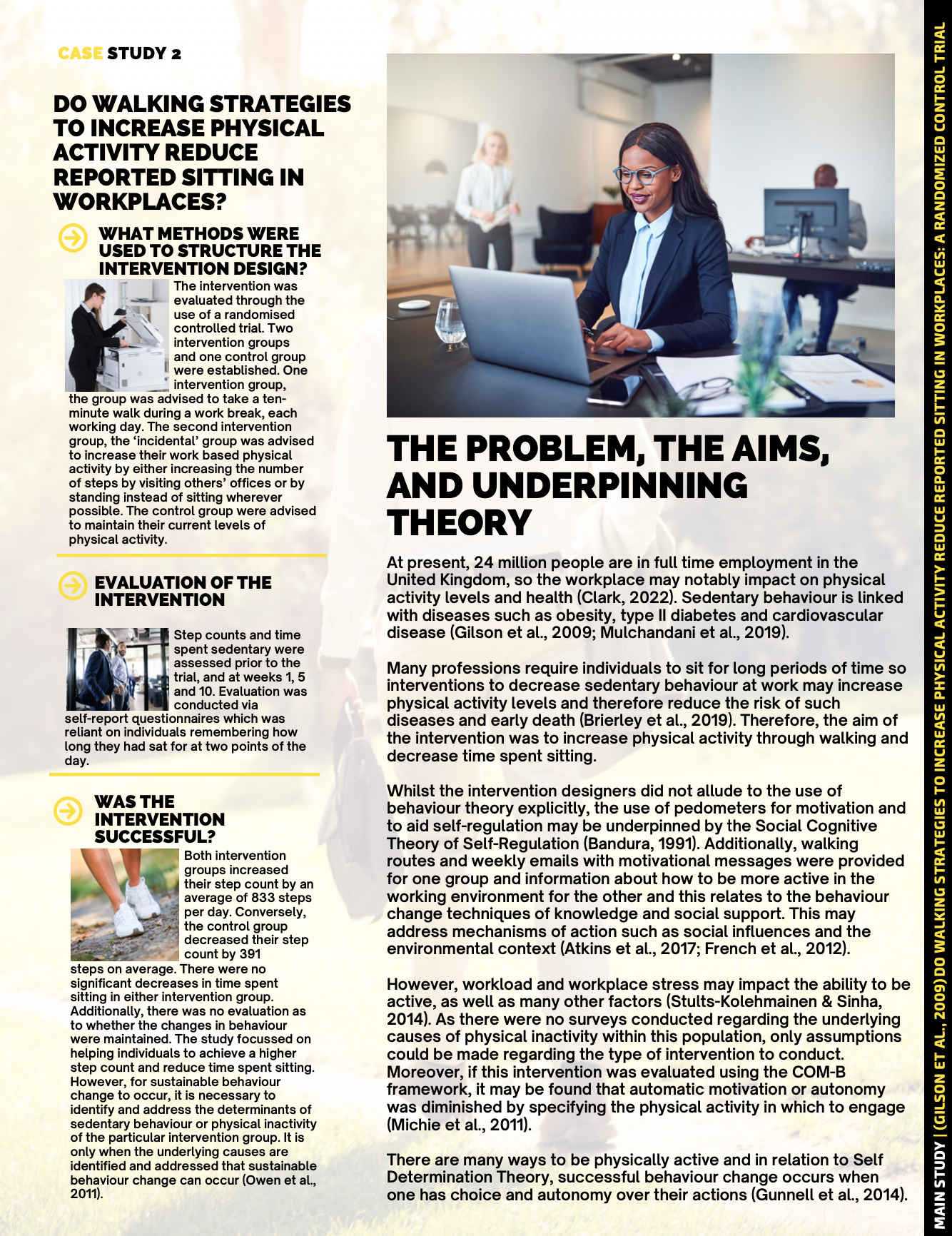
School-based, peer-led physical activity intervention for Year 8 girls

Do walking strategies to increase physical activity reduce reported sitting in workplaces?

References
Atkins, L., Francis, J., Islam, R., O’Connor, D., Patey, A., Ivers, N., Foy, R., Duncan, E. M., Colquhoun, H., Grimshaw, J. M., Lawton, R., & Michie, S. (2017). A guide to using the Theoretical Domains Framework of behaviour change to investigate implementation problems. Implementation Science, 12(1). https://doi.org/10.1186/s13012-017-0605-9
Bandura, A. (1991). Social cognitive theory of self-regulation. Organizational Behavior and Human Decision Processes, 50(2). https://doi.org/10.1016/0749-5978(91)90022-L
Brierley, M. L., Chater, A. M., Smith, L. R., & Bailey, D. P. (2019). The Effectiveness of Sedentary Behaviour Reduction Workplace Interventions on Cardiometabolic Risk Markers: A Systematic Review. In Sports Medicine (Vol. 49, Issue 11). https://doi.org/10.1007/s40279-019-01168-9
Cancer Research UK. (2019). Uterine cancer statistics. Https://Www.Cancerresearchuk.Org/Health-Professional/Cancer-Statistics/Statistics-by-Cancer-Type/Uterine-Cancer#heading-Six.
Chan, A. W., Tetzlaff, J. M., Gøtzsche, P. C., Altman, D. G., Mann, H., Berlin, J. A., Dickersin, K., Hróbjartsson, A., Schulz, K. F., Parulekar, W. R., Krleza-Jeric, K., Laupacis, A., & Moher, D. (2013). SPIRIT 2013 explanation and elaboration: guidance for protocols of clinical trials. BMJ (Clinical Research Ed.), 346. https://doi.org/10.1136/bmj.e7586
Clark, D. (2022, March 15). Number of full-time workers in the United Kingdom from May 1992 to January 2022. Https://Www.Statista.Com/Statistics/1119783/Full-Time-Workers-in-the-Uk/.
Crozier, S., & Jarman-Howe, M. (2020, February 28). Domestic Abuse Policy Framework. Https://Assets.Publishing.Service.Gov.Uk/Government/Uploads/System/Uploads/Attachment_data/File/877643/Domestic-Abuse-Pf.Pdf.
Field, B., Booth, A., Ilott, I., & Gerrish, K. (2014). Using the Knowledge to Action Framework in practice: a citation analysis and systematic review. In Implementation science : IS (Vol. 9). https://doi.org/10.1186/s13012-014-0172-2
French, S. D., Green, S. E., O’Connor, D. A., McKenzie, J. E., Francis, J. J., Michie, S., Buchbinder, R., Schattner, P., Spike, N., & Grimshaw, J. M. (2012). Developing theory-informed behaviour change interventions to implement evidence into practice: a systematic approach using the Theoretical Domains Framework. Implementation Science, 7(1). https://doi.org/10.1186/1748-5908-7-38
Grimmett, C., Corbett, T., Brunet, J., Shepherd, J., Pinto, B. M., May, C. R., & Foster, C. (2019). Systematic review and meta-analysis of maintenance of physical activity behaviour change in cancer survivors. In International Journal of Behavioral Nutrition and Physical Activity (Vol. 16, Issue 1). https://doi.org/10.1186/s12966-019-0787-4
Gunnell, K. E., Crocker, P. R. E., Mack, D. E., Wilson, P. M., & Zumbo, B. D. (2014). Goal contents, motivation, psychological need satisfaction, well-being and physical activity: A test of self-determination theory over 6 months. Psychology of Sport and Exercise, 15(1). https://doi.org/10.1016/j.psychsport.2013.08.005
Hawkes, R. E., Warren, L., Cameron, E., & French, D. P. (2022). An evaluation of goal setting in the NHS England diabetes prevention programme. Psychology and Health, 37(2). https://doi.org/10.1080/08870446.2021.1872790
Hoffmann, T. C., Glasziou, P. P., Boutron, I., Milne, R., Perera, R., Moher, D., Altman, D. G., Barbour, V., Macdonald, H., Johnston, M., Kadoorie, S. E. L., Dixon-Woods, M., McCulloch, P., Wyatt, J. C., Phelan, A. W. C., & Michie, S. (2014). Better reporting of interventions: Template for intervention description and replication (TIDieR) checklist and guide. BMJ (Online), 348. https://doi.org/10.1136/bmj.g1687
Kitson, A., & Straus, S. E. (2010). The knowledge-to-action cycle: Identifying the gaps. In CMAJ (Vol. 182, Issue 2). https://doi.org/10.1503/cmaj.081231
Koutoukidis, D. A., Beeken, R. J., Manchanda, R., Burnell, M., Ziauddeen, N., Michalopoulou, M., Knobf, M. T., & Lanceley, A. (2019). Diet, physical activity, and health-related outcomes of endometrial cancer survivors in a behavioral lifestyle program: The Diet and Exercise in Uterine Cancer Survivors (DEUS) parallel randomized controlled pilot trial. International Journal of Gynecological Cancer, 29(3). https://doi.org/10.1136/ijgc-2018-000039
Koutoukidis, D. A., Lopes, S., Atkins, L., Croker, H., Knobf, M. T., Lanceley, A., & Beeken, R. J. (2018). Use of intervention mapping to adapt a health behavior change intervention for endometrial cancer survivors: The shape-up following cancer treatment program. BMC Public Health, 18(1). https://doi.org/10.1186/s12889-018-5329-5
McIntyre, S. A., Francis, J. J., Gould, N. J., & Lorencatto, F. (2018). The use of theory in process evaluations conducted alongside randomized trials of implementation interventions: A systematic review. In Translational Behavioral Medicine(Vol. 10, Issue 1). https://doi.org/10.1093/tbm/iby110
Michie, S., van Stralen, M. M., & West, R. (2011). The behaviour change wheel: A new method for characterising and designing behaviour change interventions. Implementation Science, 6(1). https://doi.org/10.1186/1748-5908-6-42
Mulchandani, R., Chandrasekaran, A. M., Shivashankar, R., Kondal, D., Agrawal, A., Panniyammakal, J., Tandon, N., Prabhakaran, D., Sharma, M., & Goenka, S. (2019). Effect of workplace physical activity interventions on the cardio-metabolic health of working adults: Systematic review and meta-analysis. In International Journal of Behavioral Nutrition and Physical Activity (Vol. 16, Issue 1). https://doi.org/10.1186/s12966-019-0896-0
Owen, N., Sugiyama, T., Eakin, E. E., Gardiner, P. A., Tremblay, M. S., & Sallis, J. F. (2011). Adults’ sedentary behavior: Determinants and interventions. In American Journal of Preventive Medicine (Vol. 41, Issue 2). https://doi.org/10.1016/j.amepre.2011.05.013
Sebire, S. J., Banfield, K., Campbell, R., Edwards, M. J., Kipping, R., Kadir, B., Garfield, K., Matthews, J., Blair, P. S., Lyons, R. A., Hollingworth, W., & Jago, R. (2019). A peer-led physical activity intervention in schools for adolescent girls: a feasibility RCT. Public Health Research, 7(16). https://doi.org/10.3310/phr07160
Soni, A., Beeken, R. J., McGowan, L., Lawson, V., Chadwick, P., & Croker, H. (2021). ‘Shape-Up’, a Modified Cognitive-Behavioural Community Programme for Weight Management: Real-World Evaluation as an Approach for Delivering Public Health Goals. Nutrients, 13(8). https://doi.org/10.3390/nu13082807
Stults-Kolehmainen, M. A., & Sinha, R. (2014). The effects of stress on physical activity and exercise. In Sports Medicine(Vol. 44, Issue 1). https://doi.org/10.1007/s40279-013-0090-5
Timms, C., Brough, P., O’Driscoll, M., Kalliath, T., Siu, O. L., Sit, C., & Lo, D. (2015). Flexible work arrangements, work engagement, turnover intentions and psychological health. Asia Pacific Journal of Human Resources, 53(1). https://doi.org/10.1111/1744-7941.12030
White, M., Adams, J., & Heywood, P. (2009). How and why do interventions that increase health overall widen inequalities within populations? In Social Inequality and Public Health. https://doi.org/10.2307/j.ctt9qgz3s.10
